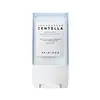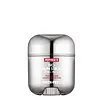What's inside
What's inside
 Key Ingredients
Key Ingredients

 Benefits
Benefits

 Concerns
Concerns

 Ingredients Side-by-side
Ingredients Side-by-side

Methyl Methacrylate Crosspolymer
Synthetic Wax
AbrasiveCoco-Caprylate/Caprate
EmollientCetyl Ethylhexanoate
EmollientButylene Glycol Dicaprylate/Dicaprate
EmollientDibutyl Adipate
EmollientButyloctyl Salicylate
Skin ConditioningVinyl Dimethicone/Methicone Silsesquioxane Crosspolymer
Silica
AbrasiveDiethylamino Hydroxybenzoyl Hexyl Benzoate
UV FilterDicaprylyl Carbonate
EmollientIsopropyl Palmitate
EmollientEthylhexyl Triazone
UV AbsorberTocopheryl Acetate
AntioxidantDiethylhexyl 2,6-Naphthalate
EmollientVinyldimethicone
Polysilicone-15
UV FilterBis-Ethylhexyloxyphenol Methoxyphenyl Triazine
Skin ConditioningOzokerite
Emulsion StabilisingMelia Azadirachta Leaf Extract
Skin ConditioningMelia Azadirachta Flower Extract
Skin ConditioningCoccinia Indica Fruit Extract
Skin ConditioningSolanum Melongena Fruit Extract
Skin ConditioningAloe Barbadensis Flower Extract
EmollientCurcuma Longa Root Extract
MaskingCorallina Officinalis Extract
Skin ConditioningOcimum Sanctum Leaf Extract
Skin ConditioningCentella Asiatica Extract
CleansingAgave Tequilana Leaf Extract
AstringentDiospyros Kaki Leaf Extract
Skin ProtectingCamellia Sinensis Leaf Extract
AntimicrobialCastanea Crenata Shell Extract
Skin ConditioningCarthamus Tinctorius Flower Extract
Skin ConditioningZanthoxylum Piperitum Fruit Extract
Skin ConditioningCoffea Arabica Seed Extract
MaskingVitis Vinifera Fruit Extract
Skin ConditioningPolygonum Cuspidatum Root Extract
AntioxidantSimmondsia Chinensis Seed Oil
EmollientSodium Hyaluronate
HumectantBisabolol
MaskingGlyceryl Caprylate
EmollientCaprylyl Glycol
EmollientPolyglyceryl-4 Diisostearate/Polyhydroxystearate/Sebacate
EmulsifyingEthylhexylglycerin
Skin ConditioningWater
Skin ConditioningHydrolyzed Hyaluronic Acid
HumectantButylene Glycol
Humectant1,2-Hexanediol
Skin ConditioningGlycerin
HumectantHyaluronic Acid
HumectantMethyl Methacrylate Crosspolymer, Synthetic Wax, Coco-Caprylate/Caprate, Cetyl Ethylhexanoate, Butylene Glycol Dicaprylate/Dicaprate, Dibutyl Adipate, Butyloctyl Salicylate, Vinyl Dimethicone/Methicone Silsesquioxane Crosspolymer, Silica, Diethylamino Hydroxybenzoyl Hexyl Benzoate, Dicaprylyl Carbonate, Isopropyl Palmitate, Ethylhexyl Triazone, Tocopheryl Acetate, Diethylhexyl 2,6-Naphthalate, Vinyldimethicone, Polysilicone-15, Bis-Ethylhexyloxyphenol Methoxyphenyl Triazine, Ozokerite, Melia Azadirachta Leaf Extract, Melia Azadirachta Flower Extract, Coccinia Indica Fruit Extract, Solanum Melongena Fruit Extract, Aloe Barbadensis Flower Extract, Curcuma Longa Root Extract, Corallina Officinalis Extract, Ocimum Sanctum Leaf Extract, Centella Asiatica Extract, Agave Tequilana Leaf Extract, Diospyros Kaki Leaf Extract, Camellia Sinensis Leaf Extract, Castanea Crenata Shell Extract, Carthamus Tinctorius Flower Extract, Zanthoxylum Piperitum Fruit Extract, Coffea Arabica Seed Extract, Vitis Vinifera Fruit Extract, Polygonum Cuspidatum Root Extract, Simmondsia Chinensis Seed Oil, Sodium Hyaluronate, Bisabolol, Glyceryl Caprylate, Caprylyl Glycol, Polyglyceryl-4 Diisostearate/Polyhydroxystearate/Sebacate, Ethylhexylglycerin, Water, Hydrolyzed Hyaluronic Acid, Butylene Glycol, 1,2-Hexanediol, Glycerin, Hyaluronic Acid
Triethylhexanoin
MaskingCeresin
Emulsion StabilisingAcrylates Copolymer
Water
Skin ConditioningDiethylamino Hydroxybenzoyl Hexyl Benzoate
UV FilterIsononyl Isononanoate
EmollientIsoamyl Laurate
EmollientDibutyl Adipate
EmollientIsoamyl P-Methoxycinnamate
UV AbsorberButyloctyl Salicylate
Skin ConditioningCaprylic/Capric Triglyceride
Masking4-Methylbenzylidene Camphor
UV AbsorberEthylhexyl Palmitate
EmollientEuphorbia Cerifera Wax
Polymethyl Methacrylate
Ozokerite
Emulsion StabilisingZinc Oxide
Cosmetic ColorantTitanium Dioxide
Cosmetic ColorantGlycerin
HumectantNiacinamide
SmoothingNylon-12
Phytosteryl/Isostearyl/Cetyl/Stearyl/Behenyl Dimer Dilinoleate
Skin ConditioningMicrocrystalline Wax
Emulsion StabilisingSorbitan Sesquioleate
Emulsifying1,2-Hexanediol
Skin ConditioningBis-Diglyceryl Polyacyladipate-2
EmollientSorbitan Olivate
EmulsifyingAluminum Hydroxide
EmollientStearic Acid
CleansingTocopherol
AntioxidantButylene Glycol
HumectantEthylhexylglycerin
Skin ConditioningAdenosine
Skin ConditioningGlycine Soja Oil
EmollientDisodium EDTA
Dioscorea Japonica Root Extract
Skin ConditioningAloe Barbadensis Leaf Extract
EmollientLaminaria Japonica Extract
Skin ProtectingUlmus Davidiana Root Extract
Skin ConditioningViola Mandshurica Flower Extract
AntioxidantPolyglyceryl-3 Diisostearate
EmulsifyingFructan
Skin ConditioningOryza Sativa Germ Extract
EmollientOryza Sativa Extract
AbsorbentBHT
AntioxidantCimicifuga Racemosa Root Extract
AntimicrobialAngelica Gigas Root Extract
Skin ConditioningGlycyrrhiza Glabra Root Extract
BleachingMorus Alba Bark Extract
Skin ConditioningPhellinus Linteus Extract
Skin ConditioningPolygonum Multiflorum Root Extract
Skin ConditioningPaeonia Lactiflora Root Extract
Skin ConditioningSophora Flavescens Root Extract
AntioxidantScutellaria Baicalensis Root Extract
AstringentSesamum Indicum Seed Extract
Skin ConditioningPvp
Emulsion StabilisingHydrogenated Polyisobutene
EmollientCynanchum Atratum Extract
Skin ConditioningLycopodium Clavatum Extract
Skin ConditioningEquisetum Arvense Extract
AstringentPropanediol
SolventBiosaccharide Gum-4
Skin ConditioningSodium Hyaluronate
HumectantHydrolyzed Elastin
EmollientAtelocollagen
Skin ConditioningDesamido Collagen
Skin ConditioningHydrolyzed Collagen
EmollientHydroxypropyl Cyclodextrin
MaskingPolysorbate 80
EmulsifyingSoluble Collagen
HumectantHydrolyzed Hyaluronic Acid
HumectantHydrolyzed Sodium Hyaluronate
Skin ConditioningUbiquinone
AntioxidantCollagen
MoisturisingCollagen Amino Acids
MoisturisingAstaxanthin
Skin ConditioningGlutathione
Sodium Benzoate
MaskingFullerenes
AntimicrobialHexapeptide-9
Skin ConditioningAcetyl Hexapeptide-8
HumectantCopper Tripeptide-1
Skin ConditioningProcollagen
Skin ConditioningHydroxypropyltrimonium Hyaluronate
Nonapeptide-1
Skin ConditioningPalmitoyl Pentapeptide-4
Skin ConditioningPalmitoyl Tetrapeptide-7
Skin ConditioningPalmitoyl Tripeptide-1
Skin ConditioningPalmitoyl Tripeptide-5
Skin ConditioningSodium Acetylated Hyaluronate
HumectantTripeptide-1
Skin ConditioningAcetyl Tetrapeptide-2
Skin ConditioningDimethylsilanol Hyaluronate
HumectantAnemarrhena Asphodeloides Root Extract
Skin ConditioningSodium Hyaluronate Crosspolymer
HumectantHyaluronic Acid
HumectantPentylene Glycol
Skin ConditioningPotassium Hyaluronate
Skin ConditioningParfum
MaskingTriethylhexanoin, Ceresin, Acrylates Copolymer, Water, Diethylamino Hydroxybenzoyl Hexyl Benzoate, Isononyl Isononanoate, Isoamyl Laurate, Dibutyl Adipate, Isoamyl P-Methoxycinnamate, Butyloctyl Salicylate, Caprylic/Capric Triglyceride, 4-Methylbenzylidene Camphor, Ethylhexyl Palmitate, Euphorbia Cerifera Wax, Polymethyl Methacrylate, Ozokerite, Zinc Oxide, Titanium Dioxide, Glycerin, Niacinamide, Nylon-12, Phytosteryl/Isostearyl/Cetyl/Stearyl/Behenyl Dimer Dilinoleate, Microcrystalline Wax, Sorbitan Sesquioleate, 1,2-Hexanediol, Bis-Diglyceryl Polyacyladipate-2, Sorbitan Olivate, Aluminum Hydroxide, Stearic Acid, Tocopherol, Butylene Glycol, Ethylhexylglycerin, Adenosine, Glycine Soja Oil, Disodium EDTA, Dioscorea Japonica Root Extract, Aloe Barbadensis Leaf Extract, Laminaria Japonica Extract, Ulmus Davidiana Root Extract, Viola Mandshurica Flower Extract, Polyglyceryl-3 Diisostearate, Fructan, Oryza Sativa Germ Extract, Oryza Sativa Extract, BHT, Cimicifuga Racemosa Root Extract, Angelica Gigas Root Extract, Glycyrrhiza Glabra Root Extract, Morus Alba Bark Extract, Phellinus Linteus Extract, Polygonum Multiflorum Root Extract, Paeonia Lactiflora Root Extract, Sophora Flavescens Root Extract, Scutellaria Baicalensis Root Extract, Sesamum Indicum Seed Extract, Pvp, Hydrogenated Polyisobutene, Cynanchum Atratum Extract, Lycopodium Clavatum Extract, Equisetum Arvense Extract, Propanediol, Biosaccharide Gum-4, Sodium Hyaluronate, Hydrolyzed Elastin, Atelocollagen, Desamido Collagen, Hydrolyzed Collagen, Hydroxypropyl Cyclodextrin, Polysorbate 80, Soluble Collagen, Hydrolyzed Hyaluronic Acid, Hydrolyzed Sodium Hyaluronate, Ubiquinone, Collagen, Collagen Amino Acids, Astaxanthin, Glutathione, Sodium Benzoate, Fullerenes, Hexapeptide-9, Acetyl Hexapeptide-8, Copper Tripeptide-1, Procollagen, Hydroxypropyltrimonium Hyaluronate, Nonapeptide-1, Palmitoyl Pentapeptide-4, Palmitoyl Tetrapeptide-7, Palmitoyl Tripeptide-1, Palmitoyl Tripeptide-5, Sodium Acetylated Hyaluronate, Tripeptide-1, Acetyl Tetrapeptide-2, Dimethylsilanol Hyaluronate, Anemarrhena Asphodeloides Root Extract, Sodium Hyaluronate Crosspolymer, Hyaluronic Acid, Pentylene Glycol, Potassium Hyaluronate, Parfum
 Reviews
Reviews

Ingredients Explained
These ingredients are found in both products.
Ingredients higher up in an ingredient list are typically present in a larger amount.
1,2-Hexanediol is a synthetic liquid and another multi-functional powerhouse.
It is a:
- Humectant, drawing moisture into the skin
- Emollient, helping to soften skin
- Solvent, dispersing and stabilizing formulas
- Preservative booster, enhancing the antimicrobial activity of other preservatives
Butylene Glycol (or BG) is used within cosmetic products for a few different reasons:
Overall, Butylene Glycol is a safe and well-rounded ingredient that works well with other ingredients.
Though this ingredient works well with most skin types, some people with sensitive skin may experience a reaction such as allergic rashes, closed comedones, or itchiness.
Learn more about Butylene GlycolButyloctyl Salicylate is a chemical UV filter structurally similar to octisalate. It is a photostabilizer, SPF booster, emollient and solvent. This ingredient helps evenly spread out ingredients.
According to a manufacturer, it is suitable for pairing with micro Titanium Dioxide, Zinc Oxide, and pigments.
Photostabilizers help stabilize UV-filters and prevents them from degrading quickly.
Learn more about Butyloctyl SalicylateDibutyl Adipate is an emollient and solvent. It is created from butyl alcohol and adipic acid.
As a solvent, Dibutyl Adipate helps mix and disperse ingredients evenly.
Dibutyl Adipate is soluble in water and organic solvents. It does not absorb UV rays.
Learn more about Dibutyl AdipateDiethylamino Hydroxybenzoyl Hexyl Benzoate (DHHB) is a chemical UV-A absorber. It is formulated for high UVA protection (320-400 nm).
DHHB is well-liked for:
DHHB has been approved by the EU, Japan, Taiwan, and South America for use up to 10%. Unfortunately, it has not been approved for use in the US or Canada due to slow regulatory processes.
This ingredient is soluble in oils, fats, and lipids.
Learn more about Diethylamino Hydroxybenzoyl Hexyl BenzoateEthylhexylglycerin (we can't pronounce this either) is commonly used as a preservative and skin softener. It is derived from glyceryl.
You might see Ethylhexylglycerin often paired with other preservatives such as phenoxyethanol. Ethylhexylglycerin has been found to increase the effectiveness of these other preservatives.
Glycerin is already naturally found in your skin. It helps moisturize and protect your skin.
A study from 2016 found glycerin to be more effective as a humectant than AHAs and hyaluronic acid.
As a humectant, it helps the skin stay hydrated by pulling moisture to your skin. The low molecular weight of glycerin allows it to pull moisture into the deeper layers of your skin.
Hydrated skin improves your skin barrier; Your skin barrier helps protect against irritants and bacteria.
Glycerin has also been found to have antimicrobial and antiviral properties. Due to these properties, glycerin is often used in wound and burn treatments.
In cosmetics, glycerin is usually derived from plants such as soybean or palm. However, it can also be sourced from animals, such as tallow or animal fat.
This ingredient is organic, colorless, odorless, and non-toxic.
Glycerin is the name for this ingredient in American English. British English uses Glycerol/Glycerine.
Learn more about GlycerinHyaluronic acid is naturally found in healthy skin. It is a humectant, meaning it draws moisture to your skin.
This ingredient helps hydrate, soothe, and protect the skin.
What makes hyaluronic acid so hydrating? It has the capacity to bind or hold large amounts of water.
Fun fact: It is already naturally found in our bodies, such as the fluids of our eyes and our joints.
Studies find this ingredient to have anti-inflammatory and anti-microbial properties. This can help speed up wound-healing.
Hyaluronic acid can be irritating if the molecule has a low-molecular weight, or if the molecules are small.
One study found low-molecular weight hyaluronic acid to be pro-inflammatory, meaning some people may experience irritation. This is because our bodies use hyaluronic acid in the wound-healing process to signal to our bodies, via irritation, that something needs healing.
The same study found high-molecular weight hyaluronic acid to be anti-inflammatory.
These are some other common types of Hyaluronic Acid:
Learn more about Hyaluronic AcidHydrolyzed Hyaluronic Acid is a form of hyaluronic acid. It is created by the hydrolysis of hyaluronic acid with a high molecular weight. Once created, Hydrolyzed Hyaluronic Acid has a low molecular weight.
Low molecular weight HA has been shown to hydrate and increase elasticity of the skin. Increasing elasticity is also associated with reduction of wrinkle depth.
One study found topical low molecular weight hyaluronic acid may be considered for the treatment of rosacea in the adult population. However, we always recommend speaking with a professional about your skin concerns.
Hyaluronic acids are a humectant. This means they draw moisture from the air. Hyaluronic acids help moisturize, soothe, and protect the skin.
Read more about other common forms of hyaluronic acid:
Learn more about Hydrolyzed Hyaluronic AcidOzokerite is a naturally occuring mineral wax. In cosmetics, ozokerite is used as a texture enhancer.
Ceresin wax is derived from this ingredient.
The melting point of ozokerite is 58-100 C.
Ozokerite is found all over the world including Scotland, the US, and India.
Learn more about OzokeriteSodium Hyaluronate is hyaluronic acid's salt form. It is commonly derived from the sodium salt of hyaluronic acid.
Like hyaluronic acid, it is great at holding water and acts as a humectant. This makes it a great skin hydrating ingredient.
Sodium Hyaluronate is naturally occurring in our bodies and is mostly found in eye fluid and joints.
These are some other common types of Hyaluronic Acid:
Learn more about Sodium HyaluronateWater. It's the most common cosmetic ingredient of all. You'll usually see it at the top of ingredient lists, meaning that it makes up the largest part of the product.
So why is it so popular? Water most often acts as a solvent - this means that it helps dissolve other ingredients into the formulation.
You'll also recognize water as that liquid we all need to stay alive. If you see this, drink a glass of water. Stay hydrated!
Learn more about Water